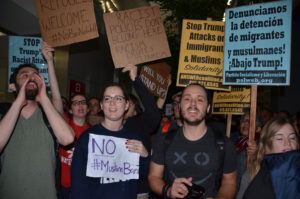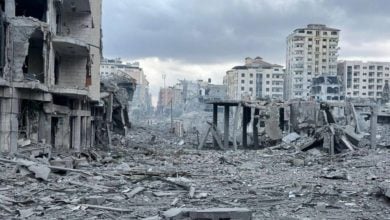
On June 26, the United States Supreme Court agreed to a partial lifting of the stay on President Donald Trump’s executive order banning travel from six Muslim-majority countries. With this move, the court has essentially given the green light to discriminatory policies to take effect over the summer, until the Court reconvenes to hear arguments on the merits of the travel ban in October.
This summertime application of the travel ban is essentially the third version of the president’s “Protecting the Nation from Foreign Terrorist Entry Into the United States” executive order. The original order, signed in January, included Iraq, Iran, Sudan, Somalia, Syria, Yemen, and Libya, suspended the refugee resettlement program for 120 days, and barred all travel from these countries for 90 days. Massive pushback against this blatantly Islamaphobic order erupted immediately, causing scenes of thousands of people coming together to protest at major airports nationwide, demanding the order be overturned and sending the message that immigrants and refugees are welcome here. A lower court quickly placed a stay on the ban.
In March, a revised version of the executive order rolled out, excluding Iraq from the original list, allowing green-card holders through, and toning down some of the more obvious anti-Muslim language. The xenophobic intention behind the order, however, was still clear. This second incarnation of the ban was also blocked by a lower court.
The ban is more limited this time, in theory allowing travelers from the six named countries to still enter the U.S., as long as they have proof of a “bona fide” relationship in the country (family, work, school). The 120-day suspension of the refugee resettlement program goes back into effect, leaving the most vulnerable immigrants in confusing and dangerous legal limbos.
With the court allowing for parts of the travel ban to be revived, there is some uncertainty about how these will be applied at the border. How will Customs and Border Protection agents gauge credibility of a “bona fide” relationship for people seeking entry into the U.S.? How much proof will travelers have to show?
Trump ran on racist, anti-immigrant, Islamophobic platform
Donald Trump ran on a campaign of anti-Muslim and anti-immigrant rhetoric, early on promising to ban Muslim people from entering the country. He claims that this travel ban is in the interest of “national security” against “terrorist threats,” feeding into the racist and misguided notion that Muslim equals terrorist. Since his election win, and through his first half-year in the oval office, the United States has seen a rise in Islamaphobia. This includes the horrific murders of two men in Portland, who were defending a young Muslim woman and her friend from the verbal abuse of a white supremacist, and the more recent case of Nabra Hassanen, a 17-year old Muslim girl brutally killed in Sterling, Va.
Even a partial and temporary victory for this executive order gives strength to this dangerous wave of bigotry in the country.
It cannot, of course, be ignored that while Trump’s xenophobia is especially extreme, anti-immigrant sentiment is nothing new. The U.S. has a long history of fearing “the foreigner,” from the 20th century anti-communist trend that targeted European immigrants, to the modern-day narrative of Mexican “drug smugglers” and Muslim “terrorists.”
This current trend of anti-Muslim rhetoric began in earnest after September 11, 2001, with Muslim communities being scapegoated and closely surveilled. Former President Obama himself was responsible for the deportation of over two million people, interrupting lives and separating families, much like Trump’s executive order did when it was first implemented in January. Democratic Party candidate Hillary Clinton was in favor of sending back young Central American refugees.
All of these reactionary policies fail to address the root causes of why people leave their homelands in the first place: poverty due to neoliberal, U.S.-influenced or imposed economic policies in their countries, the growing effects of climate change rendering some regions uninhabitable, and, as in the case of the six countries on the travel ban list, imperialist intervention and warfare that make life at home too dangerous to remain.
Root of refugee crisis: imperialism
The United States’ thirst for profit and geopolitical domination has manifested in drone strikes and destruction. In Syria, ongoing attempts at regime change by the U.S. and its allies continue to fuel a six-year civil war that has killed thousands and handed much power to ISIS in the region. In Yemen, the Saudi-led and U.S.-funded bombing campaign has resulted in famine and a deadly cholera epidemic. And Libya, once a country that offered universal healthcare and guaranteed access to education for women, is today seeing the growth of a racist slave market, following the U.S.-instrumented overthrow and murder of Moammar Gaddafi.
When the original executive order was signed, people shut down airports across the country, bringing the type of attention and resistance needed for the lower courts to take action to block the ban, and to act swiftly again, when version two came around.
Many progressives rushed to thank the courts and judges, undervaluing the role the people had played in fighting this racist policy. The revival of the Muslim ban shows that when living in a system inherently stacked against true democracy and human rights, reforms, such as the temporary stays by the lower courts, can be easily rolled back on the whims of the ruling class. And it will be done so by the very institutions we are told will protect justice in this country.
It is even more important now to continue the fightback, with mass showings of people power. The airport occupations in January proved that when the people are mobilized and united, much can be accomplished. That energy needs to be kept alive to ensure those victories remain in place, and so that the whole bigoted Trump agenda, and that of the capitalist, imperialist class, can be defeated.






